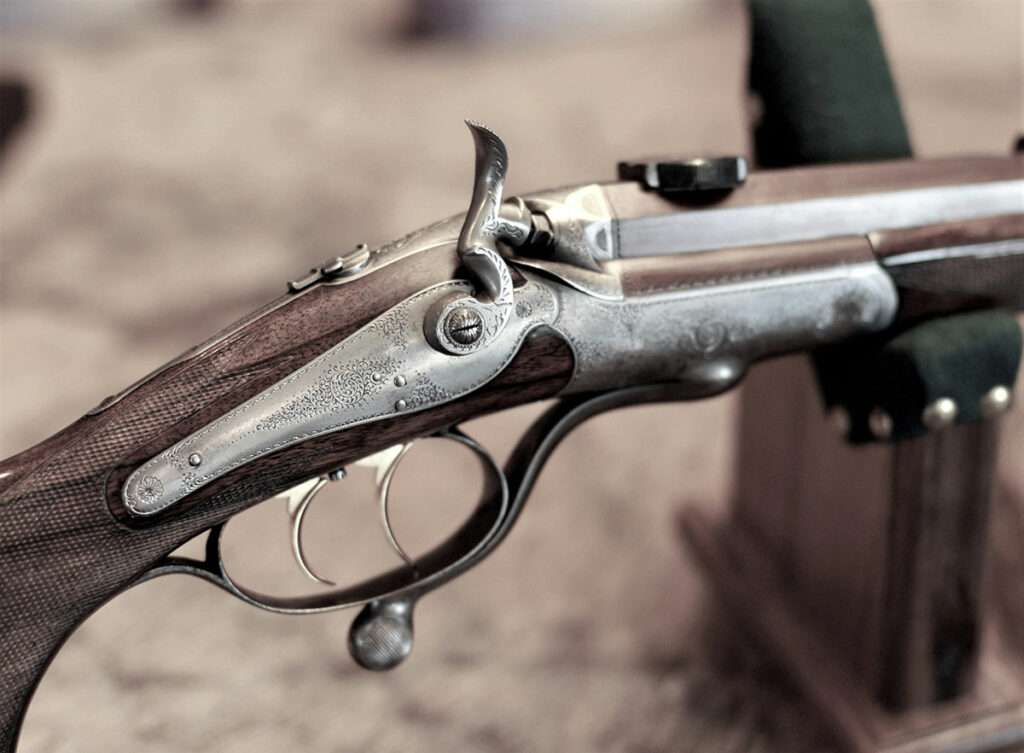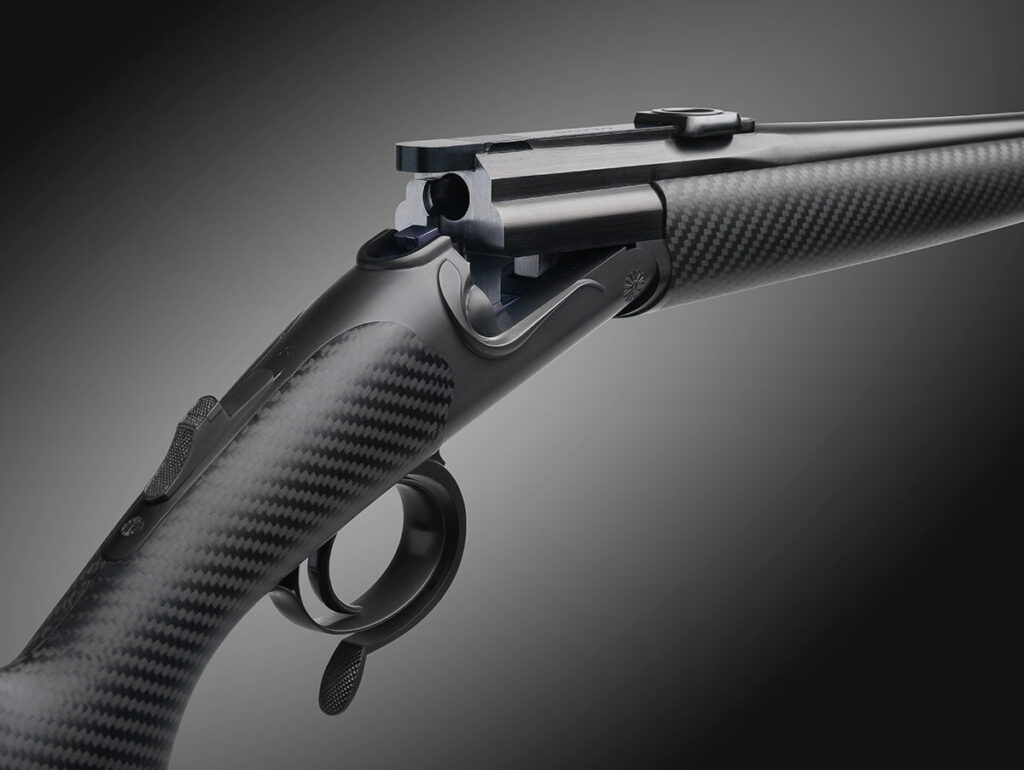Kipplauf: Both A Type Of Rifle And A Hunting Ethic
Mention the word “kipplauf” around a hunting campfire and chances are there will be blank stares on faces as the dancing flames light up the night.
Yet, the kipplauf is an important part of both firearms and hunting heritage. Certainly, its roots are embedded in the foundation of both the freedom to hunt and in the conservation of wildlife resources – the two prongs of Safari Club International’s mission.
For those who don’t know the difference between a kipplauf and a loaf of bread, a kipplauf is a relatively short, breakdown, single-shot stalking rifle.
Its ethic is to deliver a well-placed single shot that will dispatch the game animal quickly and cleanly. It is the essence of meeting nature face-to-face and knowing there is but one shot and that it must be precise.

For purists, the ethic also reflects self-imposed demands of excellence, reflected in the seamless melding of rifle and hunter so as to be one within themselves while also being one with nature. On a more utilitarian front; short, lightweight kipplaufs can be disassembled and carried in a backpack when negotiating rough terrain in the high mountains.
The late 1800s and early 1900s were periods of enlightenment for both hunting and wildlife conservation/management. It is probably not ironic that similar changes in attitudes about wildlife conservation popped up more or less simultaneously in different parts of the world, albeit for somewhat different reasons and with somewhat different interpretations.
The common impetus was a significant loss of what had seemed endless wildlife resources, especially in Europe and North America, due to human over-exploitation and over-consumption. In other words, humans were killing wildlife much faster than wildlife could reproduce.
Out of this epiphany on both sides of the Atlantic Ocean came what is now known as “sustainable use” of wildlife resources – that humans will act in ways that assure that the use of wildlife resources is sustainable forever. Safari Club International, along with SCI Foundation, is the leading hunting organization in the world in promoting this conservation concept.
Theodore Roosevelt has been credited with leading that charge in North America with what has been coined the North American Model of conservation of wildlife resources. But even before Teddy began that movement in North America, the sustainable use concept was already budding in Europe.
Archduke John of Austria developed the European version of sustainable use in the 1850s, a move that also led to a change in who could hunt. Before that, only the aristocracy was allowed to hunt, and there were excesses in their methods of take.
In North America, market hunting was the practice that threatened to harm various native wildlife species ranging from bison to birds. In Europe, where nobility determined the destiny of wildlife, excessive hunting practices also accounted for what was then becoming a dearth of wildlife resources.

Although the traditional practices on both continents were different, their results were similar. In Europe, the refinement of the single-shot rifle emerged as the embodiment of the hunting/conservation ethic. It wasn’t until a little later, actually in the 20th Century, that the institution of the limited magazine capacity, specifically for migratory birds, became the embodiment of the ethic in North America.
Interestingly, perhaps even with a bit of irony thrown in for good measure, both the rifle and the ethic of what would become the modern form of wildlife conservation evolved from poacher roots.
Before the kipplauf and before the adoption of conservation thinking in the realm of hunting in Austria, the concept that only the aristocracy was allowed to hunt spawned a poaching ethic among the common folk, who took game as a source of food and who needed to defend themselves against damage to crops by an overabundance of game animals for the aristocracy to hunt. We’re talking about some unhappy campers here.
Since it was illegal for these commoners to hunt the game animals, they needed to be as circumspect as possible. As a result, they needed to make sure that the animals went down quickly because chasing them around the countryside would have exposed them to risk of being seen and captured.
Hence, the use of a short rifle and ethic of one shot, one quick kill.
Archduke John ruled in 1850: “The game should no longer be merely an object of the lust for hunting.” In addition to the right to hunt, there also was then an obligation “to look after the game, to preserve the game, and to treat the game with respect.”
The Archduke’s rifle was a flintlock with a short octagonal barrel in caliber 15.5mm (groove)/14.2mm (rifling). It sported a set trigger and open sights. It also had a wooden trigger guard with brass-covered ramrod eyelets and buttplate.
What has become known as the more modern iteration of the kipplauf rifle was introduced by Emperor Franz Joseph I (1830–1916) – the “eternal” last emperor of the Habsburg Danube monarchy (he ruled for 68 years).

Since it was introduced at the historic Bad Ischl summer residence of the emperor, that rifle configuration has become known as the Ischlerstutzen, or Ischler short rifle.
That rifle, chambered for the 8x50R cartridge, was crafted by the firm Johann Fanzoj in Ferlach, Austria for Emperor Franz Joseph I in 1912.
Fanzoj has continued to produce kipplaufs (or Ischler short rifles if you prefer) since and offers the widest variety of that type of rifle in the world today.
As much as the use of a single-shot rifle in connection with wildlife conservation evolved from an ethic that required the hunter to limit his or her own offtake, such a limitation manifested itself differently in North America.
In North America, the first outward evidence of limitations associated with wildlife conservation came in the form of what is now called the “duck plug.” That is a spacer that limits the number of rounds that can be held in the magazines of repeating shotguns.
With the support of then-celebrated hunters like Nash Buckingham, migratory birds in the U.S. could be hunted with guns that could hold no more than three rounds. Rather than focusing on ethics, the North Americans focused on the hardware, which, then contributed to less offtake and, in theory, less wounding of wildlife.
It seems as though that mindset continues in the U.S. where anti-gun activists push to force the limitation of the number of rounds firearm magazines can hold. But that is a different discussion.
Back to the kipplauf concept, embodied in what became known as the “Ischler short rifle.”
“More than a century ago our company Johann Fanzoj crafted this ‘Ischler short rifle’ for Austrian emperor Francis Joseph I,” Fanzoj reported. “We still build this unique hammer rifle today. A handcrafted delight with a nostalgic flair, reminiscent of bygone times and the glory of the Habsburg emperors.”
“In the past few decades some amazing rifles have emerged from our workshop,” Fanzoj continued. “A lot of water has flowed down the Loiblbach stream to Ferlach since then. Times have changed and our portfolio has expanded. At our workshop today, tradition and exceptional craftsmanship blend seamlessly with advanced technology to create unique technical and artistic masterpieces.
“We build a fascinating variety of classic models – both shotguns and rifles, as well as multi-caliber special commissions – and now work with high-tech materials such as titanium and even carbon fibre.
“Our heart still belongs to the single shot rifle. With the new model KB-1 we have introduced an evolution to the classic break-down single shot rifle that has attracted worldwide attention. Our Fanzoj Kipplauf KB-1 combines outstanding accuracy and durability with elegance and history.”
Traditional kipplauf rifles often were embellished with ornate engraving and inlays of precious metals as true examples of functional art. Certainly, Fanzoj continues to make such masterpieces. But Fanzoj doesn’t stop there. They also offer as modern a design of kipplauf possible in their KB-1 TI Carbon model.
This unique single shot rifle also is available in titanium and can be paired with a custom carbon stock –which makes it impervious to environmental factors like snow, rain or extreme temperatures.
“With this rifle we aspired to combine the best of the past with the possibilities of today,” Fanzoj noted.
Perhaps what is most alluring about the kipplauf is that it is a straight-forward expression of the pure hunting rifle. A rifle, then, that must deliver that one shot accurately. Requirements for premium hunting rifles have changed. Today’s hunters, and especially mountain hunters, expect the highest levels of performance at all distances.

This is reflected in the Fanzoj KB-1, which is a high-class, high-performance instrument — mechanically durable and very accurate.
“What makes our approach in the high-end field unique and eventually successful, I believe, is finding solutions that incorporate our craftsmanship skills for creating items of harmony and timeless value with modern high-precision functionality,” explained Daniela Fanzoj. “It is the synergy of a traditional object and modern precision tool.”
The more serious the hunter, the more important such things become. When hunters appreciate the best and demand the most from themselves and everything they use on the hunt, all is well with the world.
Single-shot hunting rifles focus on “one.” One shot when one is one with nature is the ethic of the kipplauf.–Steve Comus

